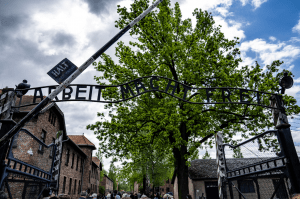Before arriving in Poland, we visited sites where most of World War II’s heroic stories unfolded. In London, the Blitz was devastating. Nonetheless, the allies were victorious, and England’s national identity remained after the war. In France, we visited Normandy and walked the same beaches as those who liberated France. In Western Europe, we saw examples of resilience, perseverance, and triumph over evil. In Krakow, however, the sites and museums did not bear the usual Western European happy ending.
About one-third of Krakow’s pre-World War II population was Jewish. They were intellectuals, doctors, lawyers, and most importantly, people. Jewish people in Krakow were Polish citizens and were incorporated into life throughout the city just like other citizens. The Nazis quickly occupied Poland and all of this changed. The Nazis treated Jewish people as less than human and made every effort to break the Jewish population. 70,000 Jewish people were relocated to a ghetto with space for 17,000 people; rations were less than three-hundred calories per day; and Nazi terrorized the community as part of their mission to gain living space. Eventually, Krakow’s Jewish population was nearly exterminated. Outside of Krakow, we visited Auschwitz-Birkenau, one of the largest and most brutal Nazi death camps. Over one million Jews and even Polish citizens were sent here, and most of them never left. These atrocities were unfathomable to me, especially considering that they happened in a modern society.
Amidst my shock and attempts to understand how Nazis created a system that murdered millions of Jews, political prisoners, gypsies, homosexuals, and other outcasts, I realized how important it is to study these catastrophes and visit sites where they took place. Visiting Auschwitz was hard. Gaining a sense of how many lives weren’t lived was even more challenging. The system responsible for nearly seven million Jewish people’s murder was created through a series of societal changes and motivated by hatred in an attempt to portray someone else as the enemy. Visiting these sites is gut wrenching, but if we don’t take time to pay respect to those who were victims of Nazi Germany or attempt to understand why these atrocities happened, we risk accepting a similar fate in the future.



